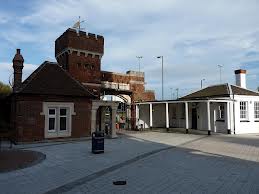 |
Once the torpedo school on Vernon had separated from Excellent other hulks wer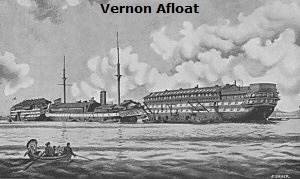 e added to the complex, all of which were moored in Fountain Lake, north of the Dockyard. First to arrive was the Ariadne (also in 1876) which served as living quarters followed by ActŠon (1876), Donegal (1886), Marlborough (1904), Warrior (1904) and a number of smaller vessels. The whole group were known collectively as Vernon with some renamed Vernon I, Vernon II and Vernon III. In 1895 the whole of Vernon was moved to Portchester Creek as Fountain Lake was becoming too crowded. e added to the complex, all of which were moored in Fountain Lake, north of the Dockyard. First to arrive was the Ariadne (also in 1876) which served as living quarters followed by ActŠon (1876), Donegal (1886), Marlborough (1904), Warrior (1904) and a number of smaller vessels. The whole group were known collectively as Vernon with some renamed Vernon I, Vernon II and Vernon III. In 1895 the whole of Vernon was moved to Portchester Creek as Fountain Lake was becoming too crowded.
It may not be obvious to us today but in 1867 the torpedo was considered to be a variety of mine so it is not surprising that the two weapons were developed alongside each other from the beginning. Both the torpedo and the mine were fired electrically, this being the first application of electricity to warfare, and as a consequence the Torpedo branch became inextricably linked with electricity.
As the two schools grew it became increasingly obvious that they could not remain afloat for ever. The first move to bring them ashore involved the Mining School which was destined for the southern half of Gunwharf, the half under the control of the navy.
Torpedo School
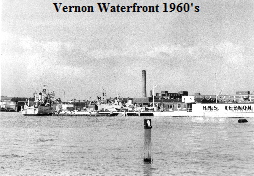 This was largely achieved by 1919 with the Torpedo and Electrical Schools following shortly after to be allocated the northern half of Gunwharf as soon as the army had vacated the premises. Once safely ashore and settled down the whole of Gunwharf became known, on 1st October 1923, as the Vernon Shore Establishment (see 1930 plan). Left behind, the ships that had formed the original Vernon were soon on their way to the breakers yards, all that is except Warrior and Marlborough which sank at sea on it's way there. This was largely achieved by 1919 with the Torpedo and Electrical Schools following shortly after to be allocated the northern half of Gunwharf as soon as the army had vacated the premises. Once safely ashore and settled down the whole of Gunwharf became known, on 1st October 1923, as the Vernon Shore Establishment (see 1930 plan). Left behind, the ships that had formed the original Vernon were soon on their way to the breakers yards, all that is except Warrior and Marlborough which sank at sea on it's way there.
Postscript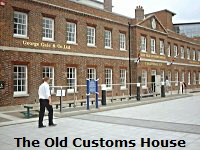 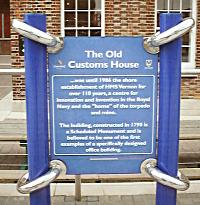
After the Vernon Shore Establishment closed in the 1990s the whole of Gunwharf was taken over by the Berkeley Group and redeveloped as a commercial centre to the north and residential accommodation to the south. Most of the original buildings were demolished but much of the boundary wall, both North and Original South Gates, the Lock Keepers Cottage, the Old Infirmary, the Grand 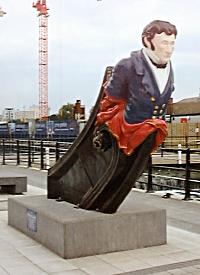 Storehouse (Vulcan Building) and the Administrative Block (The Old Customs House) have survived, as has the figurehead from the fourth ship named Vernon. Storehouse (Vulcan Building) and the Administrative Block (The Old Customs House) have survived, as has the figurehead from the fourth ship named Vernon.
The Old Customs House....was until 1986 the shore establishment of HMS Vernon for over 110 years, a centre for
innovation and invention in the Royal Navy and the "home" of the torpedo and mine
The building, constructed in 1790 is a Scheduled Monument and is believed to be one of the first examples of a specifically designed office building
Further Information
Although there are few original features or artefacts within the Old Customs House,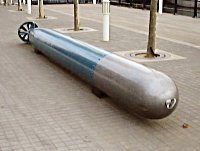 there are a number of interesting modern items and many old photographs, mainly of ships. The modern items consist largely of wooden plaques listing the names of officers who served in the various branches of the Navy based at HMS Vernon/HM Gunwharf. The building was itself formerly known as 'The Vernon Building'. there are a number of interesting modern items and many old photographs, mainly of ships. The modern items consist largely of wooden plaques listing the names of officers who served in the various branches of the Navy based at HMS Vernon/HM Gunwharf. The building was itself formerly known as 'The Vernon Building'.
In front of the building are a number of torpedoes which are deployed as public seating.
|
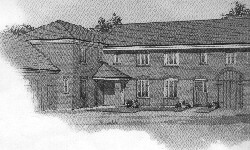


 e added to the complex, all of which were moored in Fountain Lake, north of the Dockyard. First to arrive was the Ariadne (also in 1876) which served as living quarters followed by ActŠon (1876), Donegal (1886), Marlborough (1904), Warrior (1904) and a number of smaller vessels. The whole group were known collectively as Vernon with some renamed Vernon I, Vernon II and Vernon III. In 1895 the whole of Vernon was moved to Portchester Creek as Fountain Lake was becoming too crowded.
e added to the complex, all of which were moored in Fountain Lake, north of the Dockyard. First to arrive was the Ariadne (also in 1876) which served as living quarters followed by ActŠon (1876), Donegal (1886), Marlborough (1904), Warrior (1904) and a number of smaller vessels. The whole group were known collectively as Vernon with some renamed Vernon I, Vernon II and Vernon III. In 1895 the whole of Vernon was moved to Portchester Creek as Fountain Lake was becoming too crowded.  This was largely achieved by 1919 with the Torpedo and Electrical Schools following shortly after to be allocated the northern half of Gunwharf as soon as the army had vacated the premises. Once safely ashore and settled down the whole of Gunwharf became known, on 1st October 1923, as the Vernon Shore Establishment (see 1930 plan). Left behind, the ships that had formed the original Vernon were soon on their way to the breakers yards, all that is except Warrior and Marlborough which sank at sea on it's way there.
This was largely achieved by 1919 with the Torpedo and Electrical Schools following shortly after to be allocated the northern half of Gunwharf as soon as the army had vacated the premises. Once safely ashore and settled down the whole of Gunwharf became known, on 1st October 1923, as the Vernon Shore Establishment (see 1930 plan). Left behind, the ships that had formed the original Vernon were soon on their way to the breakers yards, all that is except Warrior and Marlborough which sank at sea on it's way there. 

 Storehouse (Vulcan Building) and the Administrative Block (The Old Customs House) have survived, as has the figurehead from the fourth ship named Vernon.
Storehouse (Vulcan Building) and the Administrative Block (The Old Customs House) have survived, as has the figurehead from the fourth ship named Vernon.  there are a number of interesting modern items and many old photographs, mainly of ships. The modern items consist largely of wooden plaques listing the names of officers who served in the various branches of the Navy based at HMS Vernon/HM Gunwharf. The building was itself formerly known as 'The Vernon Building'.
there are a number of interesting modern items and many old photographs, mainly of ships. The modern items consist largely of wooden plaques listing the names of officers who served in the various branches of the Navy based at HMS Vernon/HM Gunwharf. The building was itself formerly known as 'The Vernon Building'.